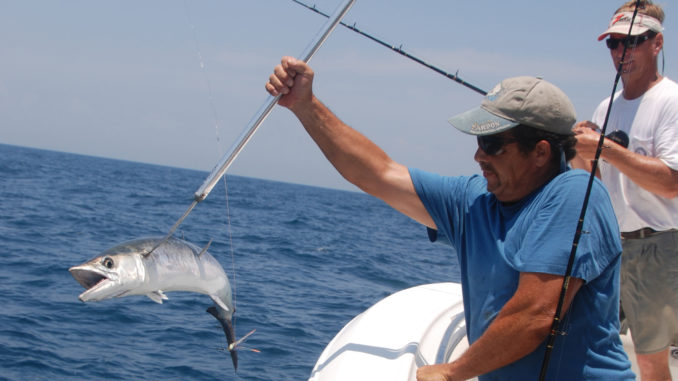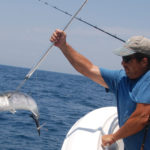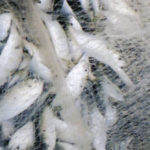
Live bait is key to great fall king fishing
Most fishermen will agree the best time to catch smoker king mackerel along the North Carolina coast is the late fall, and most agree that the best way to catch them is to use live baits. Menhaden — aka pogies, fatback, bunker — have been the preferred live bait for kings for many years. Bluefish and mullets are also considered good baits, while fishermen also use pinfish, spots, croakers, gray trout and other fish when the top ones aren’t available.
Most live baits are readily available from the late spring into the fall. Unfortunately, when the inshore and nearshore water temperatures begin dropping, the baits move on or become less active and are more difficult to catch. This usually happens sometime between mid-October and mid November, which just happens to be the prime time to catch big kings in 80 to 120 feet of water.
Earlier this year the N.C. Marine Fisheries Commission passed a regulation prohibiting the harvest of menhaden in state waters (from the beaches to three miles offshore) by mothership operations using purse seines. The N.C. General Assembly backed it up a few weeks later by making it a law. While North Carolina no longer has a menhaden-reduction fishery, boats from Omega Fisheries in Reedville, Va., were coming down, catching menhaden and taking them back to Virginia for processing. That won’t happen any longer.
If the menhaden respond as expected, forage fish and bait should be plentiful. This should be good news, as there should be plenty of food for those kings that stay through the late fall and winter.
Unfortunately, there comes a time each fall when bait suddenly becomes scarce — it really isn’t scarce, just difficult to catch. The difficulty comes from the menhaden reacting to the cooler water, staying deeper and not being visible flipping on the surface. No one will argue it is difficult to catch fish that can’t be found.
When the menhaden first move deep, the water is cool, but not cold, and they remain active, just not on the surface. This is a time to pay special attention to the pelicans and muddy spots in the water.
Birds are first. If a pelican continually circles a certain spot for a while, it sees something but believes it is too deep to catch. Often, a pelican will fly a little higher than usual, hoping not to spook the fish, and wait for them to wander close enough to the surface to catch. Sometimes the bait rises and the bird dives, and sometimes not. Sometimes you can move into the area and locate the bait on your fishfinder. Remember that most are only looking at a circle on the bottom that is roughly the same diameter as the depth of the water. The beam is a cone with its widest point at the bottom and must be almost directly over the fish to mark bait.
Don’t give up too quickly. If the pelican continues to circle, it sees something it thinks might be its next meal. Your fishfinder will probably have a more difficult time finding it. Once you find bait, a big pod can be caught with a cast net. Smaller pods or spread-out bait requires another tactic.
Often, active baitfish will stir up the bottom, creating what many fishermen call a “mud ball.” It usually takes polarized sunglasses to spot mud balls through the low angle and glare of the early morning sun, but they really pay for themselves when a mud ball is spotted.
Once a mud ball is spotted, take a few seconds to study it and see which way the bait is moving. The mud is more concentrated closer to where the fish are stirring, and it becomes diffused as they swim away from it. The cast net should be thrown at the forward end of the mud ball, where the mud is thickest, as this is the highest concentration of baitfish.
When the water cools more and baitfish pods get spread out, it’s time to put up the cast net and get out a sink net, a type of gill net that has more weight than flotation so it will sink to the bottom and fish from the bottom up.
Gill nets are considered commercial gear and can only be used by fishermen holding a SCFL (Standard Commercial Fishing License) or a RCGL (Recreational Commercial Gear License). For hook-and-line fishermen chasing bait, a RCGL is the way to go, costing $35 a year. The RCGL license allows using up to 100 yards of net. Rules are in place for marking gill nets for identification.
I learned to catch bait with a gill net more than 20 years ago at Hatteras, and it has served me well. I had some excellent teachers: charter captains Rom Whitaker, Bruce Armstrong, Steve “Creature” Coulter and Spurgeon Stowe. When the bait gets scarce at Hatteras, these captains ease along the beach, watching their fishfinders over places known to hold bait. Once they see the marks indicating bait, they drop a sink net on them. The bait isn’t circled, but the net is set across the marks on the fishfinder.
While you can’t see suspended bait except on the fishfinder, occasionally it is thick enough you can feel it hitting the net as you put it out. When this happens, the net is only left out for a few minutes before being brought in and the bait removed and put in the baitwell. Usually, the net is set over the bait marks for 10 to 15 minutes before being retrieved. Baitfish can handle this time without swimming, but they will expire if the soak time is much longer.
There are several slight variations on what fishermen consider as the best sink net. I have my preference and will offer that as a starting point. If you decide to try this, talk with fishermen who do it and with net makers or people at net shops before you decide.
I grew up calling nets by their open size, but the current trend is to call them by their stretched size. Stretched size is the measurement across a mesh that has been pulled closed, from the inside of the knot on one end of a mesh to the outside of the knot on the other end. I like to use a 1 5/8-inch (open) to 3 ¼-inch (stretched) mesh for catching fall menhaden, bluefish and other fish for bait. This net will also catch large spots if you are so inclined.
Nets made of .139 inch diameter netting are softer and will catch better, but the strands are thinner and will break or tear more easily. Durability comes with .208-inch diameter netting, but it is stiffer and doesn’t catch as well. Many fishermen find .177-inch netting a good compromise.
Gill nets are made to sink and float. The difference is in how many weights and floats the net carries. Sink nets are made to sink to the bottom and fish up from there and have more weight. Float nets are made to float and fish down from the surface, and they have more floatation. The net to catch suspended bait is a sink net.
A deep (tall) net is preferred for catching bait. This measurement is in meshes deep and 80 to 100 meshes deep equates to 10 to 14 feet. Taller nets cover more water and catch better than shorter nets. My preference is for a shorter net. Rather than trying to handle 100 yards, I would suggest buying a 50-yard net. Any net shop or net hanger can make this net, however, there is enough netting in a bundle to hang 100 yards, and many people don’t care for having the short piece left over. You may have two 50-yard nets made and sell one to a friend.




Be the first to comment